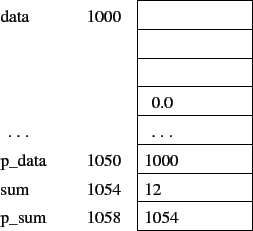double data[10];
double *p_data;
int sum;
int *p_sum;
p_data = data;
p_data[3] = 0.0;
p_sum = ∑
sum = 10;
printf("Sum: %d\n", *p_sum);
*p_sum = 12; /* Dereference the pointer */;

Tom Kelliher, CS 311
Jan. 27, 2012
Project 0 handout.
``Grand Tour.''
Continued ``Grand Tour.''
struct <struct_identifier>
{
<member_declaration>
[<member_declaration> ...]
};
/* Don't forget the semicolon!!! */
#include <stdio.h>
/* "struct dimension" becomes a new type. */
struct dimension
{
double length;
double width;
double height;
};
/* Prototypes */
void printDimension(struct dimension);
int main()
{
struct dimension box1 = { 1.0, 1.0, 1.0 };
struct dimension box2;
box2.length = 2.0;
box2.width = 4.0;
box2.height = 6.0;
printDimension(box2);
return 0;
}
void printDimension(struct dimension dim)
{
printf("Length: %g\nWidth: %g\nHeight: %g\n", dim.length,
dim.width, dim.height);
}
double data[10];
double *p_data;
int sum;
int *p_sum;
p_data = data;
p_data[3] = 0.0;
p_sum = ∑
sum = 10;
printf("Sum: %d\n", *p_sum);
*p_sum = 12; /* Dereference the pointer */;

malloc() -- memory allocation.
void *malloc(size_t size);
free() -- memory de-allocation.
void free(void *ptr)
#include <stdlib.h>.
int array:
void createAndDestroy(int size)
{
int *data;
int i;
data = (int *) malloc(size * sizeof(int));
if (data == NULL)
return;
for (i = 0; i < size; i++)
data[i] = 0;
free((void *) data);
}
/* Note use of typedef. */
typedef struct qnode {
struct qnode *next;
struct qnode *prev;
int key;
/* Additional or alternate fields here. */
} qnode;
qnode* head, temp, insert, delete;
/* Don't forget to check malloc's return value! */
head = (qnode*) malloc(sizeof(qnode));
head->next = head->prev = NULL;
head->key = 5;
temp = (qnode*) malloc(sizeof(qnode));
temp->key = 99;
head->next = head->prev = temp;
temp->next = temp->prev = head
temp = (qnode*) malloc(sizeof(qnode));
temp->key = 73;
insert = head; /* New item inserted AFTER item pointed to by insert. */
temp->next = insert->next;
temp->prev = insert;
insert->next->prev = temp;
insert->next = temp;
delete = head->prev;
/* The following is incorrect, from a memory allocation point-of-view.
* Why? How can it be fixed?
*/
free((void*) delete);
delete->prev->next = delete->next;
delete->next->prev = delete->prev;